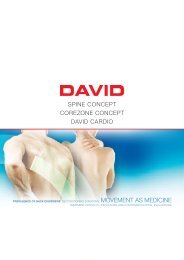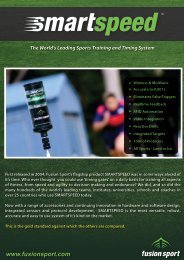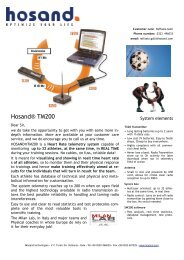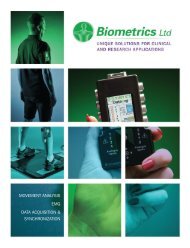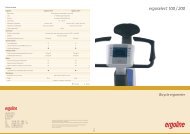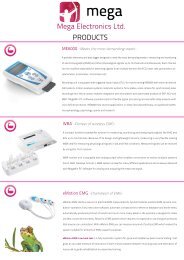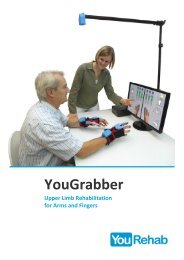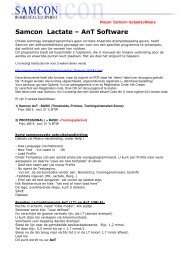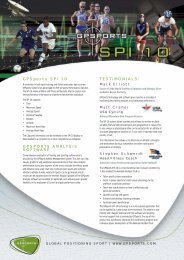Create successful ePaper yourself
Turn your PDF publications into a flip-book with our unique Google optimized e-Paper software.
<strong>SPINE</strong> <strong>CONCEPT</strong><br />
PREVALENCE OF BACK DISORDERS DECONDITIONING SYNDROME MOVEMENT AS MEDICINE<br />
TREATMENT PROTOCOL INDICATIONS AND CONTRAINDICATIONS EVALUATIONS
THE DAVID<br />
<strong>SPINE</strong> <strong>CONCEPT</strong><br />
OVERALL DESCRIPTION<br />
David Spine Concept is a comprehensive evaluation and treatment<br />
concept for back disorders. The concept uses carefully<br />
targeted movement and controlled loading to reverse the deconditioning<br />
syndrome related to back pain. Individualized<br />
programs are planned based on a questionnaire, physical<br />
evaluations and tests. Specially designed devices provide a<br />
safe and effective way of improving mobility, strength and spinal<br />
coordination. Full documentation and hands-on education<br />
ensures that any medical/physiotherapy facility can turn into a<br />
specialized spine treatment center in a short time.<br />
Medical Background<br />
PREVALENCE OF BACK DISORDERS<br />
Back pain is among the most common disorders in western societies causing more fi nancial losses to companies and insurance<br />
systems than any other single disorder except common cold. Up to 70 % of the people have experienced back pain sometime during<br />
their lives; around 40 % had an episode lasting more than a day in the last 12 months and around 25 % during the past three<br />
months.<br />
DECONDITIONING SYNDROME<br />
In most back pain cases, a specifi c diagnosis, such as disc hernia, is not possible to obtain. However, regardless of the reason<br />
of the pain, it will cause avoidance in physical activity, further weakening the strength and coordination of the back and eventually<br />
affecting the integrity of the tissue structure. This can produce a vicious cycle resulting in more pain and loss of function and if<br />
prolonged, also psychological effects. When the problem has reached this level, traditional methods of treatment are helpless and<br />
the possibility for permanent disability increases signifi cantly as time passes.<br />
MOVEMENT AS MEDICINE<br />
Several studies have shown that movement can act as medicine for painful joints. With joints like the knee, which are relatively<br />
simple structures, movements are simple and loading is easy to apply in a controlled manner. The spine, however, is a very complex<br />
structure involving vertebrae, discs, ligaments, dynamically functioning rotator and intervertebrae muscles and large, mostly<br />
statically functioning supporting muscles. When pain and loss of coordination is added into the equation, it is extremely diffi cult to<br />
start physical exercises in a controlled manner. Special devices are required to isolate the target area provide total control in the<br />
movement and loading. All movements should start with limited range and low loading, within the pain tolerance. Time is essential<br />
since physiological changes are slow. Ideal treatment should run for three months with an ongoing program afterwards.
Figure 1: The David Spine Concept treatment program consists of four distinctively<br />
different phases gradually turning an inactive and insecure patient into a<br />
confi dent and able person to meet the demands of daily physical activities<br />
Treatment protocol<br />
INDICATIONS AND CONTRAINDICATIONS<br />
Most back disorders can be treated successfully with the David Spine Concept. These include unspecifi c back pain, degenerative<br />
changes, herniations and post operative situations. Participation requires exclusion by a specialist of any contraindications and<br />
consent by treating surgeon within four months of the surgery. Contraindications include tumors, acute infl ammations, and recent<br />
fractures. Successful treatment requires patient consent and motivation to participate.<br />
EVALUATIONS<br />
Individualized programs require thorough understanding of the patient background, present condition and physical capacity.<br />
A standard evaluation protocol includes a validated questionnaire including patient background, pain profi les and self assessment.<br />
Physical therapy evaluation assesses posture, functional defi ciencies and limitations. Device based tests include strength and<br />
mobility in all movement plains. Results are recorded in a database and a very illustrative spine profi le can be printed out comparing<br />
each tests to normative data. Evaluations done pre, mid and post provide objective outcome reports for treating doctors and<br />
third-party payers as well as added motivation for the patient.<br />
TREATMENT PROGRAM<br />
The duration of a recommended treatment program is 12 weeks and 24 sessions. The length is essential, since prolonged back<br />
pain causes physiological changes in the tissue structure of the back, which take time to recover. The program is divided into<br />
phases with specifi c objectives for each phase. The Orientation Phase (Fig. 1) aims at improving spinal movement in all movement<br />
planes, segmental coordination of the spine and improving endurance capacity of the supporting muscles. During the Adaptation<br />
Phase coordination and endurance are further improved and loading is gradually increased within pain limits. Loading is increased<br />
systematically during the Exercise Phase to increase spinal stabilization and neural muscle control. During the Optimization Phase<br />
the aim is to optimize and harmonize coordination, mobility and endurance capacity of the lower spine and neck. Throughout the<br />
program selective relaxation and stretching are used together with equipment based exercises. These combined with ergonomic<br />
guidance are also used in home training.<br />
SET-UP<br />
David Spine Concept is a complete system including training and testing devices, evaluation protocol, software, documentation,<br />
education and support allowing any medical facility to start a spine rehab operation effectively and in a short period of time.<br />
For more information visit www.david.fi
TECHNOLOGY<br />
DEVICES<br />
David testing and training devices form the core of the David<br />
Spine Concept. These devices provide both safe and effective<br />
training for the most complex and diffi cult section of the human<br />
body, the spine.<br />
EMG tests show how the David F110 Lumbar / Thoracic extension unit effectively<br />
eliminates strong hip extensors targeting the movement and loading to<br />
the critical spinal region. Horizontal loading ensures low loads and minimal axial<br />
loading to the spine reducing pain during exercise.<br />
David F110 is the fi rst and most important device in the concept.<br />
It allows people with even severe and prolonged back<br />
pain, lack of coordination and strength to start mobilization<br />
and strengthening exercises of the lumbar and thoracic spine<br />
with complete safety and minimal pain. This is made possible<br />
by the unique hip fi xation, which limits the exercise to the lumbar<br />
and thoracic area practically eliminating the activation of<br />
the strong hip extensors. Movement is segmental, vertebrae<br />
by vertebrae, activating not only the static erector muscles but<br />
also the dynamic, but weak interspinales and rotatores muscles<br />
between vertebrae.<br />
Improved coordination and strength of these muscles improves<br />
postural control, while the strong erector muscles provide stability<br />
and strength.<br />
• Target muscles: Spinalis Thoracis, Iliocostalis Thoracis, Longissimus,<br />
Iliocostalis Lumborum, Spinalis, Intertrans versarii, Interspinalis<br />
• Measurements: Width 86 cm, length 176 cm, height 133 cm, weight 285 kg<br />
Restrictions in the spinal rotation are among of the fi rst defi<br />
ciencies caused by back pain. The David F120 allows exercising<br />
with precise loading and range fully adjusting to the<br />
patient’s situation. The lower body is rotated while the upper<br />
body remains fi xed. The starting position – dependent on the<br />
mobility of the user – has a stepless adjustment. This will provide<br />
a marked improvement to the motion control. The movement<br />
is carried out in two directions. The lumbar/thoracic rotation<br />
musculature is activated through eccentric and concentric<br />
movements. This allows for an extremely effective training of<br />
the oblique muscles (inner and outer lateral abdominal musculature)<br />
and the muscles of the transverso spinal system of the<br />
m. erector spinae.<br />
The David F120 Lumbar/Thoracic Rotation device is an essential<br />
component of the David Spine Concept.<br />
• Target muscles: Obliquus Externus, Obliquus Internus,<br />
Rotatores, Semispinalis, Multifi dus<br />
• Measurements: Width 86 cm, length 118 cm, height 133 cm
Another important exercise of the David Spine Concept is the<br />
lumbar/thoracic fl exion. The hip-stabilizing mechanism and<br />
the curved back padding eliminate potentially incorrect movements,<br />
which might cause stress to the lumbar spine.<br />
The result is an effective, dynamic segmental movement of the<br />
lumbar and thoracic vertebra, which will ultimately strengthen<br />
the abdominal musculature over its entire movement range.<br />
The range of movement adjustment is stepless, increasing<br />
preliminary stretching of the elastic and contractile elements<br />
of the agonist muscles. This exercise provides a most effective<br />
mobilization of the thoracic spine.<br />
The David F130 Lumbar/Thoracic Flexion device allows training<br />
of the abdominal musculature with minimum risk, even with<br />
heavy resistance loads.<br />
• Target muscles: Rectus Abdominus<br />
• Measurements: Width 86 cm, length 176 cm, height 133 cm, weight 285 kg<br />
The David Spine Concept also includes exercises for the neck<br />
and nucha area as well as for the thoracic vertebra region.<br />
To determine load dosage, the same fundamental principles<br />
used for the other functional exercises of the concept are<br />
applied. The risk of overexertion is minimized by a precisely<br />
calculated load resistance for all the varying individual training<br />
plans. The device provides analysis and training of the cervical<br />
extension, fl exion, and lateral-fl exion musculature.<br />
The mobility of the cervical spine is quantifi ed by using a<br />
special goniometer called F144 CMS Cervical Measurement<br />
System, which is adjustable according to the cranial circumference<br />
of the patient.<br />
Rehab centers expanding their fi eld of specialty to include the<br />
cervical spine area may complete their basic confi guration with<br />
additional David training equipment.<br />
• Target muscles: Splenius, Erector Spinae, Levator Scapulae,<br />
Trapezius, Sternocleidom., Longus Colli, Scalenus ant., Longus Capitis<br />
• Measurements: Width 86 cm, length 98 cm, height 133 cm<br />
The David F150 is used to quantify the mobility of the lumbar<br />
and thoracic vertebra in the frontal plane and to analyze and<br />
train the muscle strength and/or functional capacity of the isolated<br />
lumbar/thoracic lateral-fl exion musculature. Analog to the<br />
F110 and F130 units, the patient or user – depending on the<br />
position of L3 / L4 vertebra – is positioned axially correct according<br />
to the axis of rotation of the exercise device. The torso<br />
or shoulder axis is fi xed by a shoulder-stabilizing mechanism.<br />
As with the David F120, the movement is carried out in two<br />
directions, allowing the lumbar/thoracic lateral-fl exion musculature<br />
to be activated by eccentric and concentric movements<br />
as well.<br />
• Target Muscles: Quadratus Lumborum, Psoas Major<br />
• Measurements: Width 86 cm, length 103 cm, height 133 cm<br />
For more information visit www.david.fi
EVE<br />
PROFESSIONAL<br />
EVE (eValuated Exercise) Professional is a complete measurement<br />
and monitoring system designed to work together<br />
with the David Spine Concept and the Satellite Concept.<br />
It is a groundbreaking, completely networked system that<br />
gives physiotherapists and other treatment professionals<br />
location-independent access to their patient measurement<br />
and exercise data. Rehabilitation centers can share data or establish<br />
satellites at e.g. corporate prevention units. The monitoring<br />
of these satellites can be done remotely with the help of<br />
EVE Professional without sacrifi cing training quality.<br />
The easy-to-use graphical user interface of the EVE terminals<br />
give patients guidance, motivation and real-time biofeedback<br />
during their exercise. This frees time for the physiotherapists<br />
to monitor more patients at the same time without sacrifi cing<br />
quality. The system records every training session and helps<br />
physiotherapists to indentify wrong training patterns of their<br />
patients.<br />
EVE Professional redefi nes the controlling, monitoring and data<br />
collecting standards of the rehabilitation market. Welcome to<br />
the new exiting world of EVE!<br />
EVE TERMINAL<br />
REHAB CENTER<br />
• RFID recognition (only single tag per patient required)<br />
• Easily adjustable individual training programs<br />
• The graphical user interface of the EVE terminals<br />
give instructions, motivation and real-time<br />
biofeedback for patients<br />
• All training data is automatically stored and analyzed<br />
to identify wrong training patterns<br />
The terminal has a 7-inch full colour touch-screen, a powerful<br />
processor and wireless networking. Patients are recognized<br />
with RFID technology. The system is easy to use and<br />
self-explanatory. Patients get instant biofeedback during their<br />
training. Physiotherapists can perform isometric and amplitude<br />
tests easily on the spot using the testing view and the results<br />
are displayed in real-time.<br />
All measurement and exercise data is automatically and wirelessly<br />
transferred to the server and it can be accessed through<br />
EVE Professional Web Access from anywhere in the world.<br />
The EVE terminals are shipped* with the new versions of David<br />
Future Line DMS machines. The terminals are available as an<br />
upgrade option to existing DMS machines (some restrictions<br />
apply). The EVE terminals are future-proof with support for software<br />
updates and upcoming features like automated electronic<br />
seats and footplate adjustments, electro-mechanic weight<br />
stacks and seat pressure sensors. The EVE system can be<br />
purchased with an interface to the David ME6000 16-channel<br />
EMG-device.<br />
A valuable addition to the standard testing system is a possibility<br />
to analyze EMG in real-time from up to 16 channels. When strength<br />
and mobility is monitored, 14 channels are available. Special software<br />
allows multitude of analyses. The David ME6000 is an ideal<br />
tool for research oriented facilities.<br />
* The shipment of EVE systems start at the end of Q2/2009. The currently shipping<br />
Future Line DMS machines with MC2 / MC3 technology are EVE upgradable.
EVE PROFESSIONAL WEB ACCESS<br />
Web Access is used for viewing patient measurement and exercise data. Patient training programs are generated using a pre-existing<br />
template. The center administrator can modify and create new templates if necessary. The program has multiple reports including the<br />
spine profi le analysis for a single patient or a selected group. The daily activity report is a fl exible tool for monitoring the patient fl ow.<br />
The center administrator can modify the security and visibility options of the data. In the default mode all data is restricted for clinic’s internal<br />
use only. However, the clinic administrator can allow patient data access to co-operating clinics if necessary. In co-operation mode<br />
two or more clinics can share all their patient data.<br />
The program uses state of the art data encryption for all transferred and stored data. Physical server access requires biometric authentication.<br />
The security is comparable to that of internet banking.<br />
WEB ACCESS<br />
• Access to training and measurement data securely<br />
from anywhere in the world through a web browser<br />
• An intuitive easy to use user interface<br />
• No software installation required<br />
• Operating system independent<br />
• Automatic daily data backup<br />
CO-OPERATING PHYSIOTHERAPY CENTER<br />
• Patient and training data sharing possible<br />
• RFID recognition (only single tag per patient required)<br />
• Patients can exercise in any co-operating center<br />
with their personal treatment program<br />
• Centers can form large chains which can operate as one<br />
COUNTRY MASTER SERVER<br />
• Centralized exercise data gathering,<br />
analyzation, storage and real-time distribution<br />
SATELLITE CENTER (E.G.<br />
CORPORATE PREVENTION UNIT)<br />
• Exercises can be remotely monitored and training<br />
advice given through the EVE network.<br />
• Patients can pre-fi ll questionnaires through the EVE<br />
web forms.<br />
EVE user-interface views:<br />
Amplitude test Torque test Visual training feedback<br />
DAVID <strong>SPINE</strong> <strong>CONCEPT</strong> OPERATOR<br />
AND SPACE REQUIREMENTS<br />
The David Spine Concept can be installed in any professional<br />
medical facility with a responsible doctor and qualifi ed staff.<br />
Physiotherapists with special education provided by David are<br />
ideal operators of the system. The space requirements are<br />
minimal, only 35 square meters are required if receptions and<br />
other facilities exist.<br />
EDUCATION, DOCUMENTATION AND SUPPORT<br />
All facilities joining in the David Spine Concept network will<br />
get thorough education in assessing and training the patients.<br />
Specialists are available for ongoing support and inbuilt quality<br />
control with the EVE Professional system allows comparison of<br />
treatments results to national and international averages.<br />
For more information visit www.david.fi
DAVID SPORTS LTD.<br />
ADDRESS<br />
EROTTAJANKATU 15–17 A<br />
00130 HELSINKI<br />
FINLAND<br />
PHONE +358 (0) 20 759 7300<br />
FAX +358 (0) 20 759 7301<br />
GENERAL INFO<br />
info@david.fi<br />
SALES<br />
sales@david.fi<br />
SERVICE AND SPARE PARTS<br />
service@david.fi<br />
WEB<br />
www.david.fi<br />
UK BRANCH OFFICE<br />
ADDRESS<br />
21 MISSION ROAD, BROADSTONE<br />
DORSET, BH18 8JJ<br />
UNITED KINGDOM<br />
CONTACT<br />
DAN RICE<br />
PHONE +44 798 935 214<br />
E-MAIL<br />
dan.rice@david.fi<br />
Rev. 2



